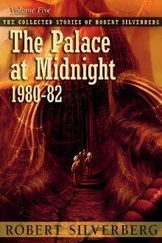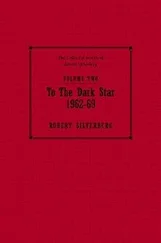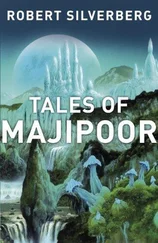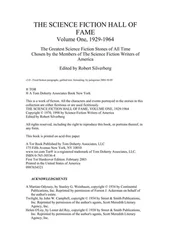Just as the Hjorts of Santhiskion city were given by nature to painstaking list-making and record-keeping and report-writing, the rural Hjorts of the valley were lovers of ritual and ceremony. Their lives revolved around their farms and their produce; everywhere about them lurked invisible gods and demons and witches, who might be threats to the ripening fields; it was necessary constantly to propitiate the benevolent beings and to ward off the depredations of unfriendly ones by acting out the rites appropriate to the day of the year. In each village there was a certain official who kept the calendar of rites, and every morning announced the proper propitiations for the week ahead. Knowing how to keep the calendar was no easy matter; lengthy training was involved, and the calendar-keeper was revered for his skills the way a priest would be, or a surgeon.
In the village of Abon Airair the calendar-keeper was named Erb Skonarij, a man so old that his pebbly-textured skin, once ashen-colored, had faded to a pale blue, and whose eyes, once splendidly huge and gleaming, now were dull and sunken into his forehead. But his mind was as alert as ever and he performed his immensely involuted cal-endrical tasks with undiminished accuracy.
“This is the tenth day of Mapadik and the fourth day of Iyap and the ninth of Tjatur,” Erb Skonarij announced, when the elders of the village came to him in the morning to hear the day’s computations. “The demon Rangda Geyak is loose among us. Thus it is incumbent on us to perform the play of the contending geyaks this evening.” And the storyteller whose responsibility it was to narrate the play of the contending geyaks began at once to make ready for the show, for among the Hjorts of the Kulit Valley no distinction was made between ritual and drama.
They had brought with them from their home world a complex calendar, or series of calendars, that bore no relation to the journey of Majipoor around its sun or to the movements of any other heavenly body: their year was 240 days long, divided into eight months of thirty days by the reckoning of one calendar, but also into twelve months of twenty days by a different reckoning, and likewise six months of forty days, twenty-four months of ten days, and 120 months of two days.
Thus any given day of the year had five different dates in the five different calendars; and on certain special conjunctions of days, especially involving the months named Tjatur in the twelve-month calendar, Iyap in the eight-month calendar, and Mapadik in the twenty-four-month calendar, particularly important holy rites had to be celebrated. And this night the conjunction of dates was such that the rite of Ktut, the war between the demons, must be enacted.
The people of Abon Airar began to gather by the storytellers’ mound at dusk, and by the time the sun had dropped behind Prezmyr Mountain the entire village was assembled, the musicians and actors were in place, the storyteller was perched atop his high seat. A great bonfire blazed in the fire pit. All eyes were on Erb Skonarij; and precisely at the moment when the hour known as Pasang Gjond arrived, he gave the signal to begin.
“For many months now,” the storyteller sang, “the two factions of the geyaks have been at war…”
The old, old story. Everyone knew it by heart.
The musicians lifted their kempinongs and heftii and tjimpins and sounded the familiar melodies, and choristers with greatly distended throat-sacs brought forth the familiar repetitive bass drone that would continue unbroken throughout the performance, and the dancers, elaborately costumed, came forth to act out the dramatic events of the tale.
“Great has been the sorrow of the village as the demons make war against each other,” sang the storyteller. “We have seen green flames darting by night among the gerribong trees. Blue flames have danced atop gravestones in the cemetery. White flames move along our roof-beams. The harm to us has been great. Many of us have fallen ill, and children have died. The garryn we have gathered has been ruined. The fields of grayven are devastated. Harvest time is almost upon us and there will be no grayven to harvest. And all of this has befallen us because there is sin in the village, and the sinners have not given themselves over to be purified. The demon Rangda Geyak moves among us—”
Rangda Geyak moved among them even as the storyteller spoke: a huge hideous figure costumed to look like an ancient female of the human kind, with a coarse mop of white hair and long, dangling breasts and great yellow crooked teeth that jutted like fangs. Red flames darted from her hair; yellow flames sprang from her fingertips. Back and forth she strode along the edge of the mound, menacing those who sat in the front rows.
“But now, the sorcerer Tjal Goring Geyak comes, and does battle with her—”
A second demon, this one a giant equipped with the four arms of a Skandar, pranced forward out of the shadows and confronted the first. Together now they danced in a circle, face to face, taunting each other and jeering, while the storyteller recited the details of their combat, telling how they hurled fiery trees at each other, and caused immense pits to open in the village square, and made the waters of the placid River Kulit surge above their banks and flood the town.
The essence of the tale was that the contest of the geyaks brought great grief and woe to the village as it raged, for the demons were unconcerned by the incidental damage they were inflicting as they struggled up and down the town and the surrounding fields. Only when the sinners who had brought this calamity upon the townsfolk came forth to confess their crimes would the demons cease their warfare and turn against the evildoers, taking up flails and wielding them as weapons to drive them out of the village.
The three dancers who were to play the guilty sinners sat to one side, watching the spectacle with everyone else. Their time to take the stage was still hours away; the storyteller must first relate in full detail the arrival of other demons, the one-winged bird and the one-legged dragon and the creature that eats its own entrails, and many more. He must speak of demonic orgies, and the drinking of blood. He must tell of transformations, the beasts that interchanged shapes. He must tell of the beautiful young women who wordlessly make obscene overtures to young men on lonely roads late at night. He must—
As the old tale unfolded Erb Skonarij, watching from the seat of privilege that was his by virtue of his decades as the village’s keeper of the calendars, felt a sudden searing pain within his skull, as though a band of hot iron had been clamped around his brain.
It was a fearful sensation. He had never known such pain.
He began to think that the hour of his death had come at last. But then, as it went on and on without surcease, the thought came to him that perhaps he would not die, that he would simply be forced to suffer like this forever.
And it was, he realized after a time, an agony not of the body, but of the spirit.
Something was striking a knife into his soul. Something was whipping his innermost self with a whip of fire. Something was hammering at the substance of his being with a massive jagged boulder.
He was the sinner. He had brought the fury of the demons down upon the village. He, he, he, the keeper of the calendars, the guardian of the ceremonies: he had failed in his task, he had violated his trust, he had betrayed those who depended on him, and unless he confessed his guilt right here and now the entire village would suffer for his iniquities.
Rising from his place of honor, he came tottering forward into the center of the stage.
“Stop!” he cried. “I am the one! I must be punished! For me, the flails! For me, the whips! Drive me out! Cast me from your midst!”
Читать дальше












